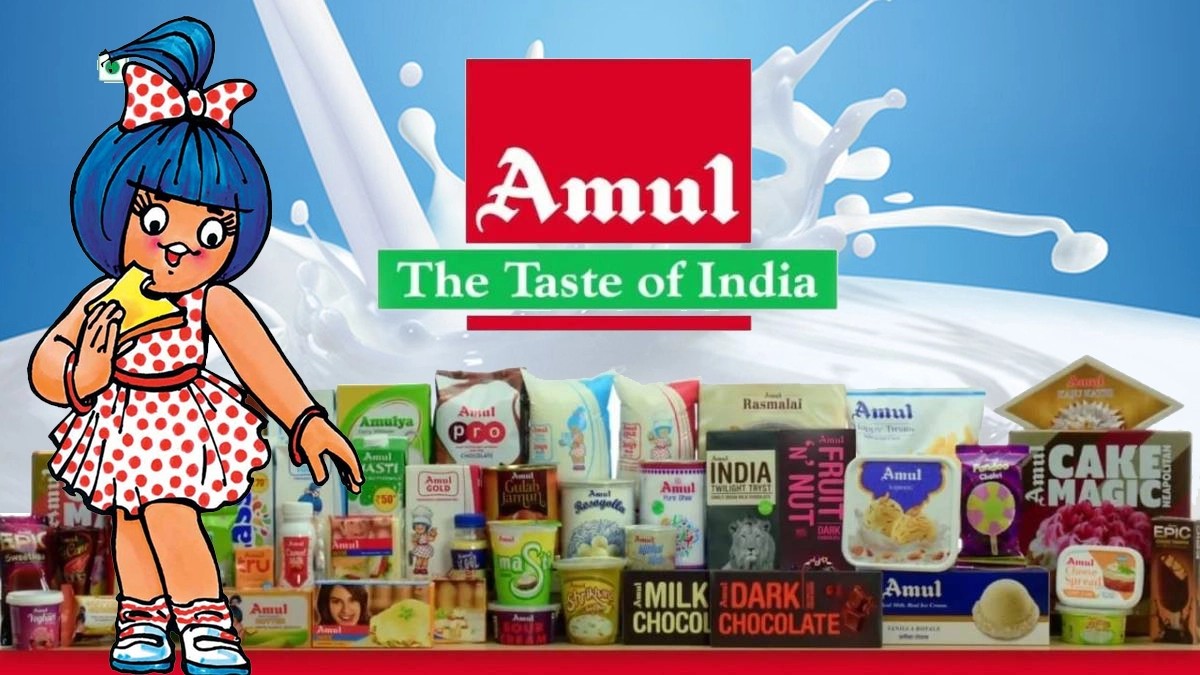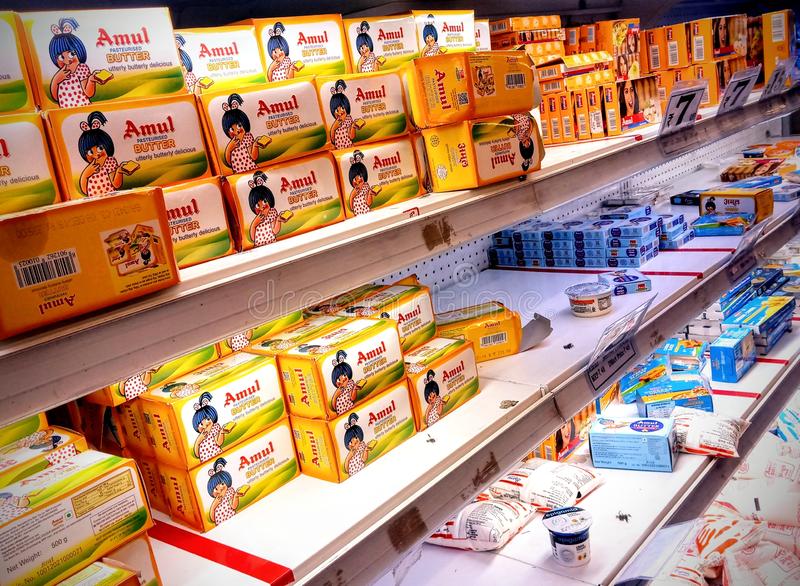The Marketing mix of Amul analyses the 4Ps of Amul, including the Product, Price, Place, and Promotions. The Amul marketing mix has combined all the elements of marketing strategies to create a comprehensive framework that can easily influence consumers to purchase Amul products. The Amul brand has become a household name thanks to the Amul business model and its marketing strategy, which has created a successful bridge between the company and the Amul Shoppers.
Amul’s marketing mix focuses on moment marketing strategy, product innovation, Amul product portfolio, Amul distribution channel strategy, pricing strategy, umbrella marketing strategy, Amul digital marketing strategy, and famous Amul girl campaigns to create brand awareness.
Quality Amul products like Amul Dairy Milk, Amul Paneer, Amul Cheese Spread, Amul Gold, amul Milk powders, Amul Butter, Amul Dahi, Amul Chocolates, Amul Milk Powder and Amul Ice Cream are an integral part of Amul portfolio through which Amul managed to create waves in the dairy industry.
Table of Contents
Introduction of Amul
- Origin Country: India
- Founder: Tribhuvandas Patel
- Owner: Gujarat Cooperative Milk Marketing Federation, Ministry of Cooperation and Government of Gujarat
- Founded: 1946
- Headquarters: Anand, Gujarat, India
- Employees in 2023: 1,000 (marketing team), 3.6 million (dairy farmers)
- Annual Revenue in 2023: 6.5 billion USD (INR 52,000 crores)
- Sales Turnover: 610 billion INR
- Brand Valuation in 2023: 3.255 billion USD
Amul or Anand Milk Union Limited is India’s largest dairy cooperative and milk product producer and one of the leading dairy processors worldwide.
The Amul Cooperative Society is owned and managed by Gujarat Cooperative Milk Marketing Federation Limited, the Government of Gujarat, and the Department of Cooperation. It is controlled by milk producers within the city.
Amul’s product portfolio includes Amul dairy products like Amul Paneer, Amul Cheese, Amul Dahi, Amul Dairy Milk, Amul Ice Cream, Amul model, and Amul Butter.
Amul Product Strategy
The product strategy in Amul’s marketing mix is about a vast product portfolio, Amul products, and product innovation. Most Indians are familiar with the catchy tunes of Amul’s advertising strategy campaigns, which signifies quality products from the brand.
Amul became the market leader in the dairy segment thanks to its vast Amul portfolio. The marketing mix of Amul’s marketing strategy advocates using the umbrella marketing strategy and Amul girl advertising campaigns to create a niche place for the brand amongst the customers. Amul product portfolio caters to a vast audience in every nook and corner of India.
The new Product Mix of Amul in 2024 is as follows (Source).
- Milk Varieties: Pasteurized milk in different fat levels, flavored milk, and buttermilk.
- Milk Powders: Includes skimmed milk powder, whole milk powder, dairy whitener, and infant milk formula.
- Butter and Ghee: Amul butter is very popular in India and produces different types of ghee (clarified butter).
- Cheese: Various types of cheese like processed cheese, cheese spreads, mozzarella, cheddar, Emmental, Gouda, and more.
- Ice Creams: A wide variety of ice creams, including cones, cups, sticks, tubs, and bulk packs.
- Yogurt and Shrikhand: Different yogurt flavors and traditional Indian sweets like Shrikhand.
- Paneer and Dahi: Cottage cheese (paneer) and curd (dahi).
- Chocolates: Amul has also ventured into the production of chocolates.
- Beverages: Energy drinks, health drinks, and café range of products.
- Other Dairy Products: These include condensed milk, cream, and Amul Mithai Mate (sweetened condensed milk).
Amul Pricing Strategy
Amul’s pricing strategy observes several vital elements that contribute to its success:
- Competitive Pricing: Amul employs a competitive pricing strategy, setting prices that are often on par or slightly lower than its competitors. This approach is crucial in maintaining its market share in the highly competitive dairy industry. Amul offers quality products at affordable prices and ensures wide accessibility and appeal.
- Cost-Plus Pricing: The cost-plus pricing model is evident in Amul’s strategy. This involves marking up the cost of production by a certain percentage to ensure profitability. Given the variability in dairy production costs, this method allows Amul to balance affordability and profit margins.
- Psychological Pricing: Amul sometimes utilizes psychological pricing tactics, like pricing products slightly below a round number (e.g., Rs.99 instead of Rs.100). This strategy is designed to make the price seem lower than it is, thereby attracting more price-sensitive customers.
- Value-Based Pricing: Amul also aligns its pricing strategy with the perceived value of its products. For instance, premium products like Amul’s gourmet ice cream or high-quality cheese variants are priced higher, targeting consumers willing to pay extra for superior quality or unique flavors.
- Dynamic Pricing: In response to market conditions, costs of production, and demand fluctuations, Amul adapts its prices. For example, pricing may be adjusted during festivals or in different seasons to optimize sales and Revenue.
- Product Line Pricing: Amul strategically prices its wide range of products to encourage customers to try different items. For example, essential products like milk and butter are priced affordably, while specialized products like gourmet cheese are priced at a premium. This encourages consumers to purchase across Amul’s product line.
By integrating quality dairy products with these diverse pricing strategies, Amul has successfully appealed to a broad spectrum of consumers, from price-conscious rural customers to quality-focused urban consumers, thus reinforcing its position as a leading player in the Indian dairy sector.
Amul Place Strategy
The state-owned Amul Cooperative Society is managed by GCMMF and controlled by milk unions from 13 districts and 3.6 million milk producers spread across 13,000 villages in Gujarat. Amul operates with the help of two divisions, Banas Dairy and Dudhsagar Dairy, and has spared its operations and product portfolio to every part of India and several overseas markets.
The Amul marketing mix focuses on distribution strategies and channels so that all Amul products reach the end consumers easily.
Here’s the place strategy of Amul.
- Extensive Distribution Network: Amul employs a robust and widespread distribution network that ensures its products are available across India. This network includes an efficient supply chain from milk collection centers to processing plants to retail outlets.
- Rural Penetration and Empowerment: A significant part of Amul’s strategy involves deep penetration into rural areas to source milk from local farmers and make its products accessible in these markets, empowering rural economies.
- Urban Market Focus: In urban areas, Amul has established a strong presence in supermarkets, grocery stores, and exclusive Amul stores, making it convenient for urban consumers to access their wide range of products.
- International Presence: Amul has expanded its footprint globally, exporting products to countries in the Middle East, the USA, Singapore, Bangladesh, and other markets, thus marking its presence in the international dairy industry.
- Online Sales and Modern Retail: Recognizing the shift towards digital platforms, Amul has ventured into online sales through its website and tie-ups with e-commerce platforms, catering to the tech-savvy and convenience-seeking urban population.
Amul Promotion Strategy
Amul’s marketing mix has focused on its promotional activities with various digital marketing channels with the help of branding, the Amul Girl mascot, hoardings, and digital campaigns. Amul does not spend too much on promotional activities as the advertising costs are within 1% of the total brand revenues.
Some Recent Video ads and Print ads for Amul are:
Liked this post? Check out the complete series on Marketing Mix


explain in detail of amuls copany in including it`s history
Well, i would recommend checking out a wikipedia article for the same because it will cover the history and other salient features of Amul in much more detail.
Pls tell me complete information about marketing mix of amul chocolate.
Amul milk is delicious. Marketing the delicious taste is required after coming to the taste level of old whole milk that was coming in glass bottles
Hi Hitesh, Can you share some documents regarding how Amul used marketing strategy and how his distribution network works.
Dear Roshan,
I was a manager in channel marketing profile before becoming a problogger. Hence i know the prowess of Amul in terms of its strong distribution network. I do not have any written document, but i rely more on personal interviews and collect knowledge accordingly. Amul mainly has 1 C&F who heavily stocks the frozen products. This C&F then supplies to distributors who in turn supply to retailers. The critical thing here are the distributors. There is a lot of poaching and whenever a competitors distributor joins Amul, there is a hike in the local distribution level. The more old and solid distributors you have, the more the strength of the brand in that area. Off course, there are many tactics which ice cream companies use to attract distributors, one of the most common being infrastructure development, like deep freezers etc. I am coming up with more articles soon on FMCG. i will write more about Amul in those articles.
i have a presentation on amul product nd i want to explain on targeting style will u help me
Amul is about to lunch a frock, cup as well as ring too , can I know about those information. Hope to see reply as soon as possible
If you are speaking about Amul macho, then it belongs to the Hosiery segment and has no connection to the FMCG brand Amul.
Kindly tell me the marketing strategies being followed by Mother Dairy for marketing its dairy products?
Which marketing model they are presently following for marketing is dairy products?
Information mentioned here is really useful and excellent….
Pls tell the marketing mix of verka products
If Amul had to create a marketing strategy to sell curd in Kerala’s urban districts , how would it go about it